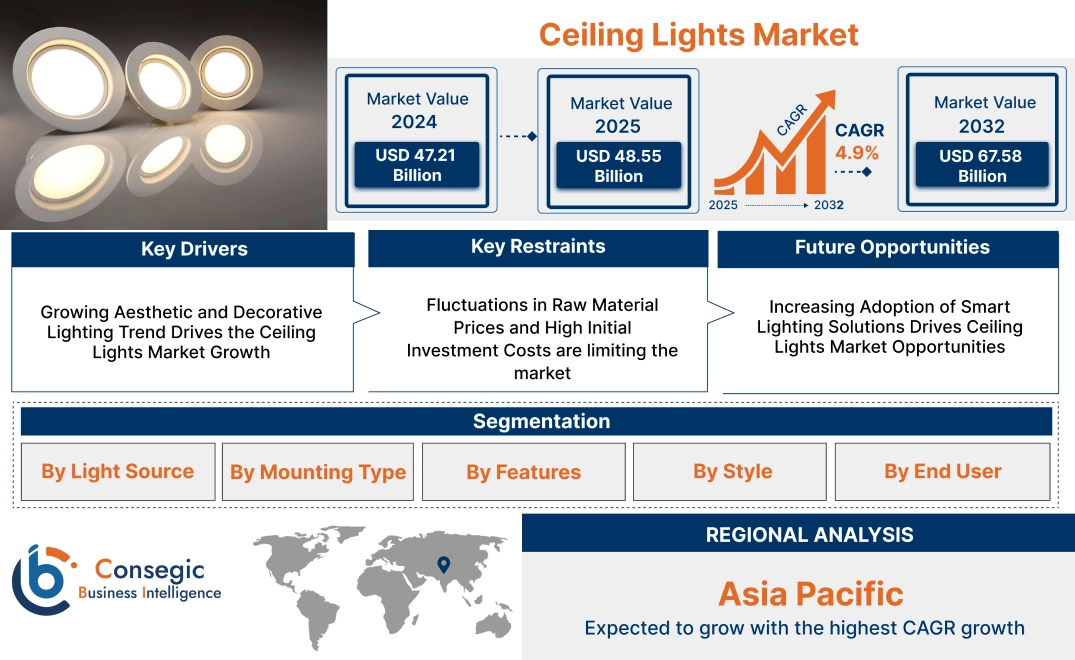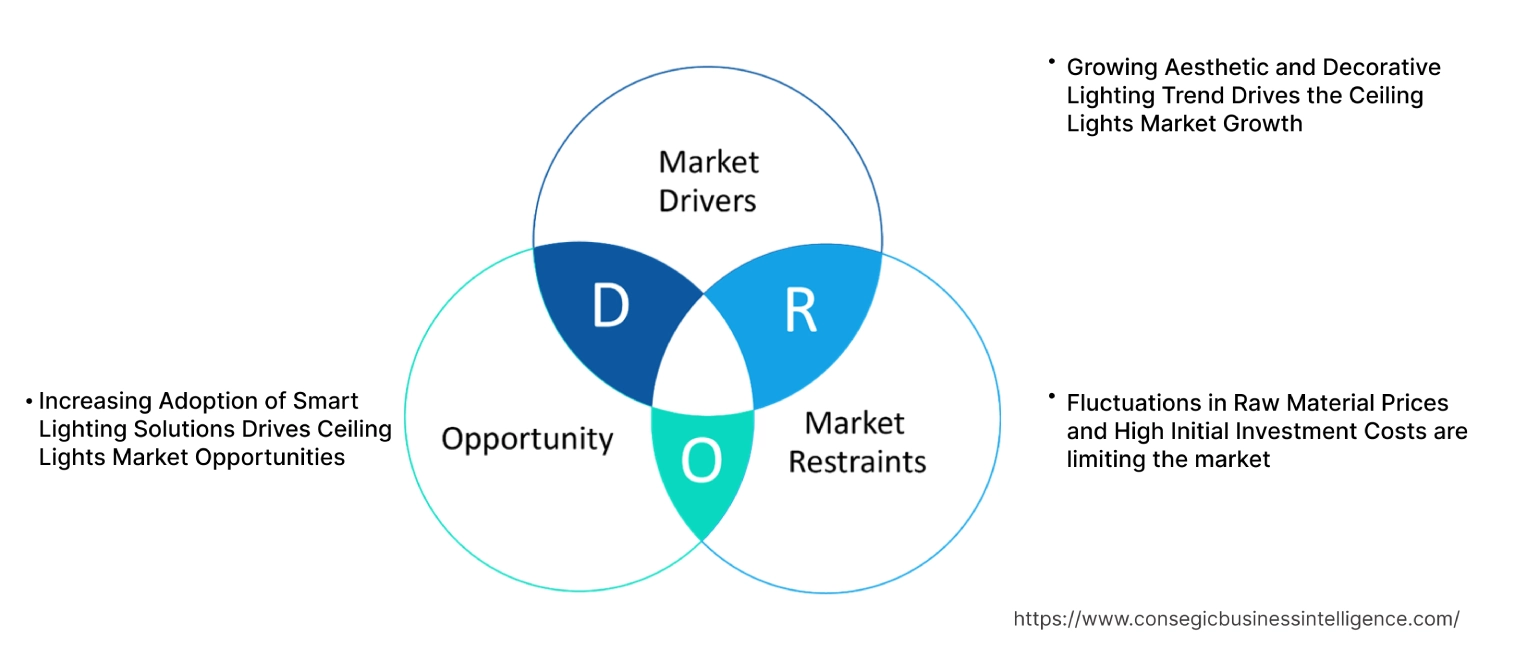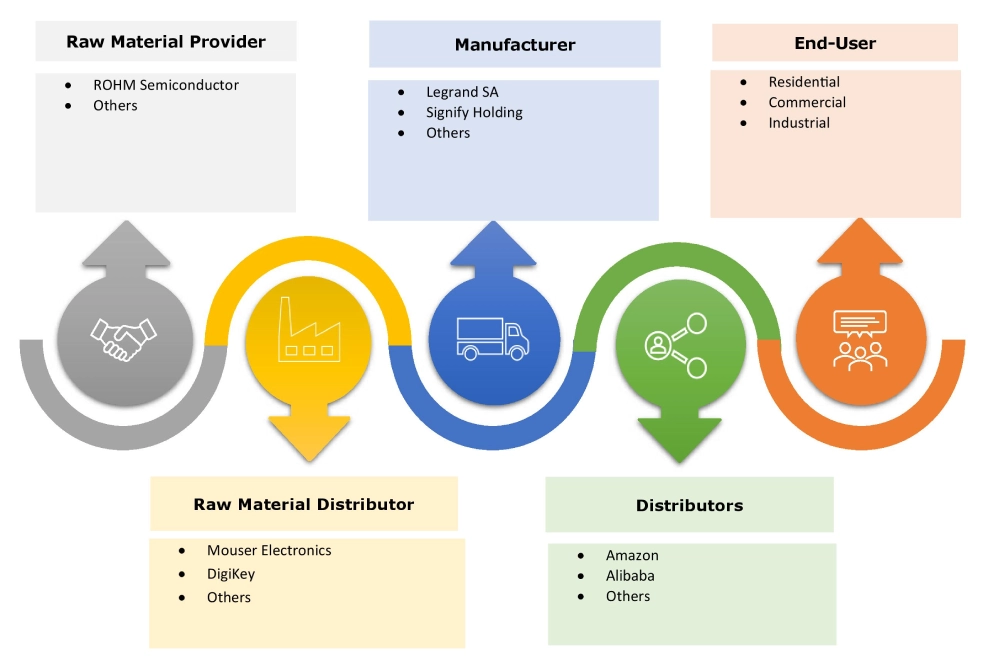- Summary
- Table Of Content
- Methodology
Ceiling Lights Market Size:
Ceiling Lights Market is estimated to reach over USD 67.58 Billion by 2032 from a value of USD 47.21 Billion in 2024 and is projected to grow by USD 48.55 Billion in 2025, growing at a CAGR of 4.9% from 2025 to 2032.
Ceiling Lights Market Scope & Overview:
Ceiling lights are lighting fixtures mounted on a ceiling to provide illumination for a room or space. They serve as a primary source of light, offering ambient, task, or accent lighting depending on their type and placement. The ceiling lights market is experiencing substantial growth, driven by growing construction industry and increasing home renovations globally. Further, technological advancements, particularly the shift towards energy-efficient LED lighting and smart home integration, are reshaping the market. Furthermore, consumers are increasingly demanding aesthetically pleasing and functional lighting solutions, leading to the development of diverse range of products.
Key Drivers:
Growing Aesthetic and Decorative Lighting Trend Drives the Ceiling Lights Market Growth
The increasing emphasis on interior design and personalized living spaces is significantly propelling the market. The consumers now view lighting as a crucial element in creating desired atmospheres and enhancing home aesthetics. This shift has led to a surge in demand for stylish, decorative fixtures that serve as focal points within rooms. Further, manufacturers are offering a diverse range of designs, finishes, and customizable options, catering to varied preferences and interior styles. Moreover, the trend is not confined to residential spaces; commercial spaces are also leveraging decorative lighting to create inviting environment which is further stimulating market growth.
- For instance, in June 2024, Philips (Signify Holding) introduced Philips Hue Datura ceiling light which provides customizable white and color light with a slim, space-enhancing design, ideal for low ceilings.
Thus, increasing focus on aesthetic and decorative lighting with substantial increases in disposable income is driving the ceiling lights market size.
Key Restraints:
Fluctuations in Raw Material Prices and High Initial Investment Costs are limiting the market
The ceiling lights market faces limitations due to the volatility of raw material prices, which directly impacts manufacturing costs and ultimately, consumer prices. These fluctuations, particularly in metals and semiconductors vital for LED production, create uncertainty for manufacturers and can deter price-sensitive consumers. Additionally, the high initial investment costs associated with advanced lighting solutions, especially smart home integrated systems and premium LED fixtures, present a significant barrier to widespread adoption. Thus, fluctuations in raw material prices and high initial investment costs are major factors limiting the market.
Future Opportunities :
Increasing Adoption of Smart Lighting Solutions Drives Ceiling Lights Market Opportunities
The expanding integration of smart home technologies is significantly broadening the prospects of the ceiling lights market. As consumers increasingly embrace interconnected living spaces, the demand for smart lighting solutions that offer convenience, control, and efficiency is surging. The manufacturers are developing advanced lighting systems that seamlessly integrate with voice assistants, smartphone applications, and home automation platforms. Further, beyond simple on/off functions, smart lighting enables customizable lighting scenes, automated schedules, and remote monitoring, enhancing user experience and energy management. Thus, increasing adoption of smart lighting solutions due to convenience, control, and efficiency, drives the ceiling lights market opportunities
Ceiling Lights Market Segmental Analysis :
By Light Source:
Based on the light source, the market is segmented into LED, fluorescent, incandescent, and halogen.
Trends in the Light Source:
- LEDs are being designed to mimic natural light patterns and promote well-being in turn driving the ceiling lights market trends.
- Incandescent and halogen lightings are experiencing significant decline due to their low energy efficiency.
LED accounted for the largest revenue share in the year 2024 and is anticipated to register the fastest CAGR during the forecast period.
- Increasing integration of LED lighting with smart home systems, enabling voice control, app-based adjustments, and automated lighting schedules, in turn drives the ceiling lights market share.
- Further, there is an increasing focus on improving LED efficiency, reducing energy consumption, and minimizing environmental impacts.
- Furthermore, LEDs offer a wide range of color temperatures and hues, allowing for customizable lighting atmospheres in residential and commercial spaces which in turn drives the ceiling lights market trends.
- Thus, as per ceiling lights market analysis, smart integration, energy efficiency, and color customization are driving the market.
By Mounting Type:
Based on the mounting type, the market is segmented into recessed, surface-mounted, pendant, and chandelier.
Trends in the Mounting Type:
- Pendant lights are becoming focal points in interior design, with a focus towards artistic form which in turn drives the ceiling lights market demand.
- LED technology is becoming more prevalent in chandeliers, improving energy efficiency and offering customizable lighting effects.
Recessed lighting accounted for the largest revenue share in the year 2024 and is anticipated to register the fastest CAGR during the forecast period.
- There's a growing need for ultra-thin recessed fixtures that seamlessly blend into ceilings, creating a clean and modern aesthetic.
- Further, recessed lights with adjustable heads and directional beams are gaining popularity, allowing for targeted illumination and accent lighting in turn driving the market.
- Furthermore, increasing integration with smart home systems is driving the market
- For instance in June 2024, Philips (Signify Holding) introduced slim recessed lights to deliver bright, colorful smart lighting in a thin profile, enabling installation in challenging spaces like false ceilings, and providing excellent light diffusion for larger areas.
- Thus, as per ceiling lights market analysis, minimalist design, adjustable and directional lighting, and smart home integration are driving the market.
By Features:
Based on the features, the market is segmented into dimmable, color-changing, voice-controlled, and smart home integration.
Trends in the Features:
- Lighting systems are becoming more seamlessly integrated with popular virtual assistants like Amazon Alexa, Google Assistant, and Apple HomeKit which in turn drives the ceiling lights market expansion.
- Color-changing lights are increasingly integrated with entertainment systems and gaming setups, creating synchronized lighting effects which subsequently propels the ceiling lights market share.
Dimmable accounted for the largest revenue share in the year 2024.
- The growing integration of dimmable lights with smart dimmers, allowing control via apps, voice assistants, and automated schedules is driving the market.
- Further, there is a growing need for more precise and flicker-free dimming, especially with LED technology.
- Furthermore, dimmable lighting is being used more and more to optimize energy savings, which in turn drives the market.
- Thus, based on analysis, advanced dimming technology and integration with smart dimmers is driving the market.
Smart home integration is anticipated to register the fastest CAGR during the forecast period.
- Smart lighting systems are increasingly designed to interoperate with other smart home devices and platforms, creating a unified ecosystem.
- Further, users can remotely monitor and control their lighting systems from anywhere in the world via smartphone apps which subsequently propels the ceiling lights market expansion.
- Furthermore, smart home systems are beginning to use data to optimize lighting performance and energy consumption.
- For instance, in March 2025, Enlighted (Siemens) launched a smart lighting control system tailored for small and medium-sized businesses. It simplifies installation through an app and laser-based sensor commissioning, making setup faster and more accurate.
- Therefore, based on analysis, aforementioned factors are anticipated to boost the growth of the market during the forecast period.
By Style:
Based on the style, the market is segmented into modern/contemporary, traditional, and coastal.
Trends in the Style:
- Traditional fixtures are increasingly incorporating LED technology to improve energy efficiency without sacrificing their classic aesthetic which in turn drives the ceiling lights market demand.
- Coastal lighting fixtures are designed to create a light and airy atmosphere, with translucent materials.
Modern/contemporary accounted for the largest revenue share of 40.96% in the year 2024 and is anticipated to register the fastest CAGR during the forecast period.
- Modern/contemporary fixtures are increasingly incorporating smart home features, such as voice control, app integration, and automated lighting scenes.
- Further, there’s a strong emphasis on using sustainable materials and energy-efficient LED technology in modern/contemporary designs which is driving the ceiling lights industry.
- For instance, Lumens, Inc. offers Louis Poulsen PH 5 Pendant Light which is a glare-free pendant lamp known for its iconic three-shade system and sandblasted glass diffuser. It provides comfortable, uniform, and primarily downward-directed light, creating soft shadows and adaptable illumination.
- Thus, as per analysis, integrated smart technology and sustainability are driving the market.
By End User:
Based on the end user, the market is segmented into residential, commercial, and industrial.
Trends in the End User:
- Commercial buildings are implementing smart lighting systems to optimize energy consumption, reduce operating costs, and meet sustainability goals, which in turn drives the ceiling lights market size.
- Industrial facilities are integrating smart lighting systems with automation and control systems to improve efficiency and safety.
Residential accounted for the largest revenue share of 50.04% in the year 2024.
- Homeowners are increasingly adopting smart lighting systems for convenience, energy efficiency, and enhanced ambiance.
- Further, there's a growing focus on using ceiling lights to create specific moods and enhance interior design.
- Furthermore, growing focus on energy efficiency and sustainability is further driving the ceiling lights market growth.
- Thus, as per analysis, smart home integration, decorative lighting, and focus on energy efficiency and sustainability are driving the market.
Commercial is anticipated to register the fastest CAGR during the forecast period.
- Increasing adoption of LED lighting in commercial spaces such as restaurants, hotels, malls and others is expected to drive the market.
- Further, commercial spaces require flexible lighting solutions that can adapt to changing layouts and needs which are driving the market
- Furthermore, growing adoption of occupancy sensors and daylight sensors is driving the market.
- For instance, Havells offers Blaze LED 20 W ceiling light which is a compact, ultra-bright recessed panel light designed for durability and safety. The key features include surge and high-voltage protection, a long lifespan of 25,000 hours, and a lightweight polycarbonate housing.
- Therefore, based on analysis, LED lighting, flexible lighting solutions, and adoption of sensors is anticipated to boost the growth of the market during the forecast period.
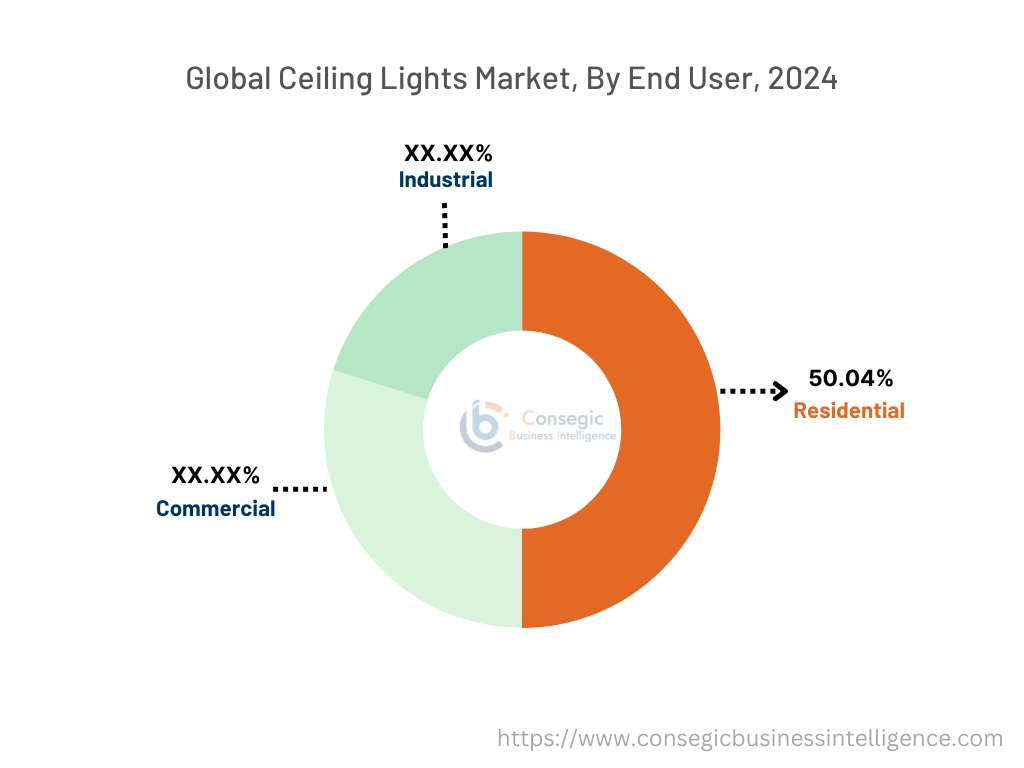
Regional Analysis:
The regions covered are North America, Europe, Asia Pacific, the Middle East and Africa, and Latin America.
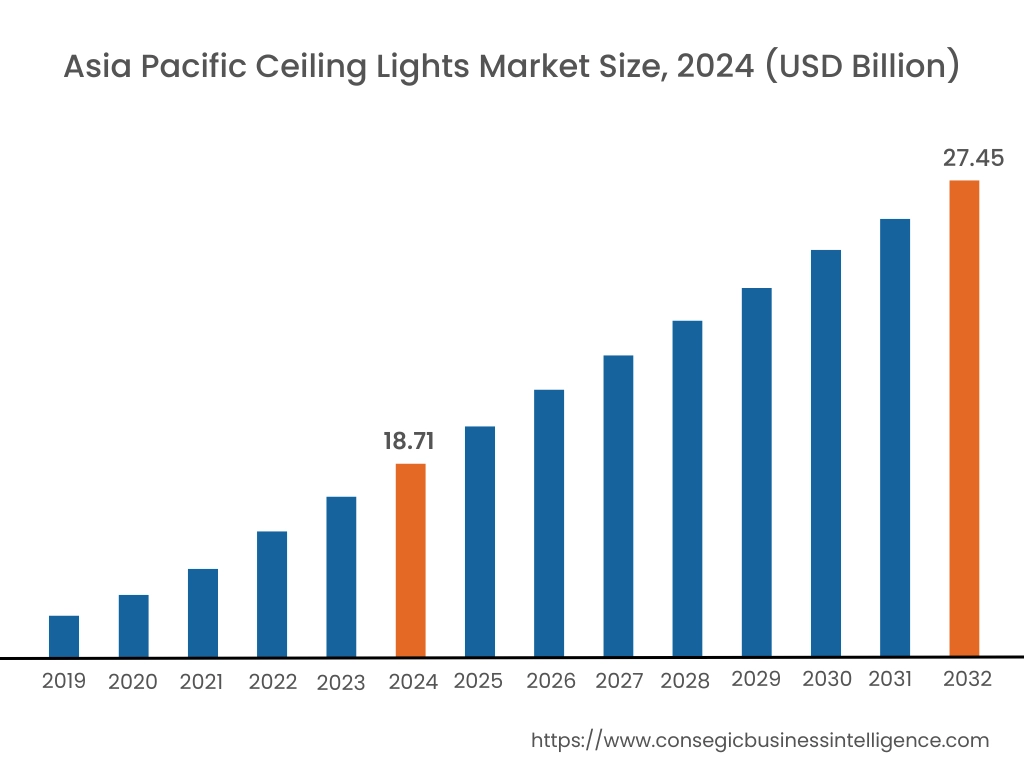
Asia Pacific region was valued at USD 18.71 Billion in 2024. Moreover, it is projected to grow by USD 19.28 Billion in 2025 and reach over USD 27.45 Billion by 2032. Out of this, China accounted for the maximum revenue share of 33.47%. The market growth for ceiling lights is mainly driven by rapid urbanization and increasing infrastructure development, leading to a surge in demand for both residential and commercial lighting solutions. Additionally, the rising adoption of energy-efficient LED technology and the growing prevalence of smart home systems are significantly contributing to the market's rise in the region.
- For instance, in January 2023, Lumary launched the "Lumary Smart RGBAI Recessed Light," a unique recessed light featuring both upward and downward lighting with RGBAI technology and a gradient auxiliary night light.
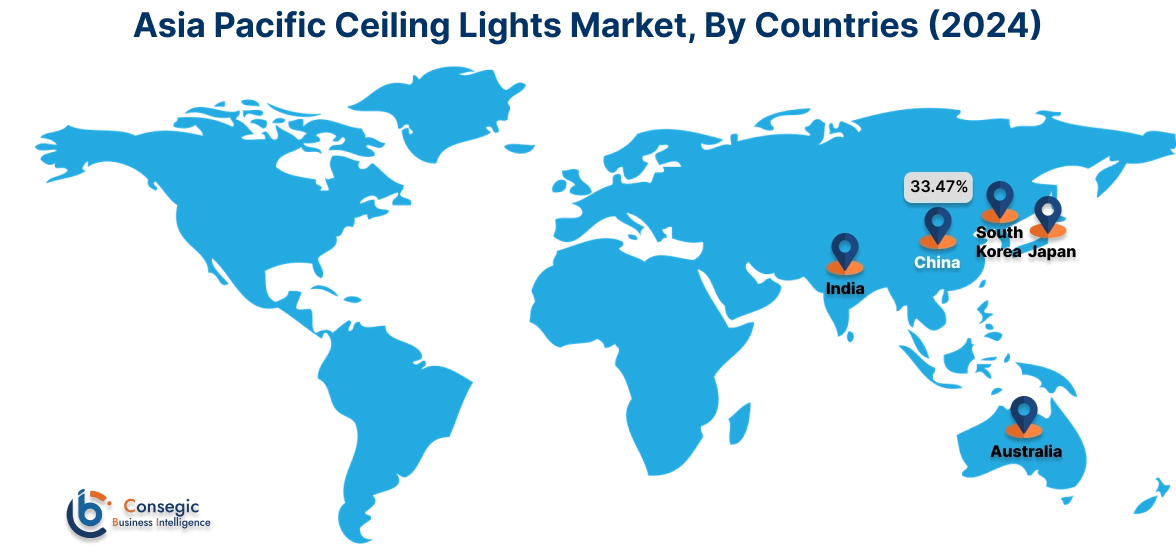
North America is estimated to reach over USD 18.73 Billion by 2032 from a value of USD 12.94 Billion in 2024 and is projected to grow by USD 13.32 Billion in 2025. The North American market is primarily driven by increasing demand for energy-efficient LED lighting solutions and the growing adoption of smart home technologies. Additionally, focus on aesthetic upgrades, are significantly contributing to market expansion in the region.
- For instance, Progress Lighting (Hubbell Incorporated) a key player in US market offers Everlume Collection of recessed downlights. The downlight is a slim, energy-efficient lighting solution designed for both residential and commercial spaces.
The regional analysis depicts stringent energy efficiency regulations and a strong consumer focus on sustainable and aesthetically pleasing lighting solutions in Europe is driving the market. Additionally, the factors driving the market in the Middle East and African region are rapid infrastructure development and expanding urban centers, coupled with growing investments in commercial and hospitality sectors. Further, increasing urbanization and rising residential construction are paving the way for the progress of market trends in Latin America region.
Top Key Players and Market Share Insights:
The global ceiling lights market is highly competitive with major players providing solutions to the national and international markets. Key players are adopting several strategies in research and development (R&D), product innovation, and end-user launches to hold a strong position in the ceiling lights industry. Key players in the global ceiling lights market include-
- Acuity Brands Lighting, Inc. (US)
- Legrand S.A. (France)
- Signify Holding (Netherlands)
- Savant Systems, Inc. (US)
- General Electric Company (US)
- Luminous Power Technologies Pvt. Ltd. (India)
- Eaton (Ireland)
- Panasonic Corporation (Japan)
- Hubbell Incorporated (US)
- Wipro Lighting (India)
- Schneider Electric (France)
Recent Industry Developments :
Product Launch:
- In August 2024, Raytec Ltd. launched SPARTAN Recess, a new line of recessed lighting for hazardous areas. This product addresses the challenges of traditional recessed lighting in such environments, which are often bulky, difficult to install and maintain, and provide uneven light distribution.
- In January 2024, Signify Holding launched NatureConnect in India, an innovative lighting system designed to bring the benefits of natural light indoors. The system consists of SkyRibbon, Daylight, and Skylight components, and integrates with control systems for customizable lighting experiences, offering visual, biological, and emotional well-being benefits.
Ceiling Lights Market Report Insights :
| Report Attributes | Report Details |
| Study Timeline | 2019-2032 |
| Market Size in 2032 | USD 67.58 Billion |
| CAGR (2025-2032) | 4.9% |
| By Light Source |
|
| By Mounting Type |
|
| By Features |
|
| By Style |
|
| By End User |
|
| By Region |
|
| Key Players |
|
| North America | U.S. Canada Mexico |
| Europe | U.K. Germany France Spain Italy Russia Benelux Rest of Europe |
| APAC | China South Korea Japan India Australia ASEAN Rest of Asia-Pacific |
| Middle East and Africa | GCC Turkey South Africa Rest of MEA |
| LATAM | Brazil Argentina Chile Rest of LATAM |
| Report Coverage |
|
Key Questions Answered in the Report
How big is the ceiling lights market? +
The ceiling lights market is estimated to reach over USD 67.58 Billion by 2032 from a value of USD 47.21 Billion in 2024 and is projected to grow by USD 48.55 Billion in 2025, growing at a CAGR of 4.9% from 2025 to 2032.
What specific segmentation details are covered in the ceiling lights report? +
The ceiling lights report includes specific segmentation details for light source, mounting type, features, style, end user, and regions.
Which is the fastest segment anticipated to impact the market growth? +
In the ceiling lights market, Modern/Contemporary is the fastest-growing segment during the forecast period.
Who are the major players in the Ceiling Lights market? +
The key participants in the Ceiling Lights market are Acuity Brands Lighting, Inc. (US), Legrand S.A. (France), Signify Holding (Netherlands), Savant Systems, Inc. (US), General Electric Company (US), Luminous Power Technologies Pvt. Ltd. (India), Eaton (Ireland), Panasonic Corporation (Japan), Hubbell Incorporated (US), Wipro Lighting (India), Schneider Electric (France) and others.
What are the key trends in the ceiling lights market? +
The ceiling lights market is being shaped by several key trends including rapid adoption of energy-efficient LED technology and the increasing integration of smart home capabilities which allows greater control and customization of lighting environments.
